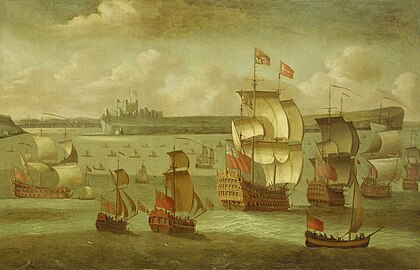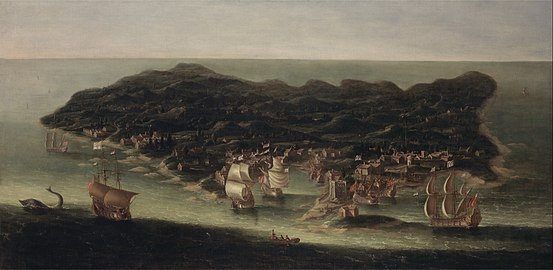Isaac Sailmaker
Isaac Sailmaker | |
|---|---|
Isaac Zeilmaker | |
 (c. 1685) Two views of an East Indiaman of the time of King William III (c. 1694), Royal Museums Greenwich | |
| Born | 1633 |
| Died | 28 June 1721 |
| Education | A pupil of George Geldorp |
| Known for | Marine painting |
Isaac Sailmaker (born Isaac Zeilmaker in Scheveningen, Dutch Republic, 1633; died in London on 28 June 1721)[note 1] was an etcher and marine painter of the Baroque period, who had a long career in England. He is sometimes referred to as "the father of British sea painting". He was eclipsed by his contemporaries, the Dutch marine painters Willem van de Velde the Elder and his son Willem van de Velde the Younger, who for a period dominated the London market, but was apparently still producing paintings in his old age.
Life
What is known about Isaac Sailmaker's life comes from notes published by the 18th century engraver, artist, and antiquary George Vertue.[2][note 2]
Isaac Zeilmaker was born in Scheveningen, in the Dutch Republic, in 1633. He came to London at a young age and became a pupil of George Geldorp, a Flemish portraitist and art dealer,[3] and so did not receive a typical marine artist's apprenticeship.[4]
An exact contemporary of the Dutch marine painter Willem van de Velde the Younger,[5] Sailmaker was eclipsed by van de Velde and his father Willem van de Velde the Elder when they moved to London in the 1670s, but he outlived them and was still painting into his eighties.[6] He was one of Britain's earliest marine painters, earning the soubriquet "the father of British sea painting".[7] Although he is supposed to have worked for England's Lord Protector, Oliver Cromwell, most of his known works date from the 1680s.[5] Vertue wrote that Sailmaker "employed himself always in painting views, small and great, many sea-ports and ships about England" and calls him "a constant labourer", which suggests that he produced a large body of work during his lifetime.[8]
An advertisement for an engraving by Sailmaker in the Term Catalogue of November 1692 stated:[9]
GLORIA Britanniae or An exact draught of the large Ship, called the Royal Prince in several postures, drawn by Mr. Isaac Saylmaker. Curiously Engraven upon a Large Copper Plate, above two foot long and a foot and nine inches deep. Price 1s. In large Dutch paper, pasted on paper and coloured, 2s. 6d.
At the end of his life, Sailmaker was living in a house aong King's Bench Walk in the Temple Bar area of the city of London. He died at home on 28 June 1721.[10]
Artistic style
Sailmaker's style is distinctive for its reliance on a relatively narrow palette, principally black, greys and greens. [11] Vertue was somewhat dismissive of Sailmaker's skill as a painter, calling him "not very excellent".[2]
Attributions
Sailmaker was once the best known of the English painters to emerged at the end of the 17th century.[5] The attribution of his paintings has been problematic for many years, as all his works were unsigned. Paintings originally said to have been created by him were later reattributed to the Dutch painter Jacob Knyff.[1][6] His identity became uncertain until the 1970s.[5]
A contemporary painting of the second Eddystone Lighthouse, built in 1709, was firmly attributed to Sailmaker in the 1970s on the basis of documentary evidence.[6][12] Other paintings have been attributed to him on the basis of engravings after his work.[10] Paintings attributed to Sailmaker include ship portraits and depictions of various naval actions, such as the Battle of Málaga (1704). He is known to have received commissions from Cromwell and the politician John Lovett, though the works produced for them have since been lost.[13] Sailmaker was commissioned by Cromwell to paint the English fleet at Fort-Mardyck, depicting its capture by an Anglo-French force in September 1657.[2]
Gallery
-
(1670) Gloria Brittaniae, or the Royal Prince Built by Sir Phin: Pett at Chatham, Royal Museums Greenwich
-
(undated) Men-o'-War and other Vessels before the Eddystone Lighthouse
-
(undated) HMS Gloucester aground on the Lemon and Ower Sandbank, off Great Yarmouth, with H.R.H. James, Duke of York aboard, 6th May 1682
-
(c. 1707) A Ship Flying the Royal Standard with other Vessels off Dover, Royal Museums Greenwich
-
(undated) The Island of Barbados, Yale Center for British Art
-
(1707/8) Ships in the Thames Estuary near Sheerness, Yale Center for British Art
Notes
- ^ Also spelt Sailmacker, Saylmaker, and Sylmaker.[1]
- ^ Vertue wrote:[2]
This man was imploy'd to paint for Oliver Cromwell a prospect of the Fleet before Mardyke when it was taken in 1657. Sept. . . . This little man imploy'd himself always in painting views small & great of many sea Ports & Shipps about England, he was a constant labourer in that way tho' not very excellent. his contemporaries the Vander Veldes where too mighty for him to cope with. but he outlivd them & painted to his last. he was born at Scheveling came very young into England. and always liv'd here. & died here at his home near the River side without the Temple Gate. call'd the Kings bench Walks. a profil off his picture painted by young Philips. who since paints conversations.
— George Vertue, Notebooks, Annual Report of the Walpole Society, volume 18, p.74
References
- ^ a b "Isaac Sailmaker". Netherlands Institute for Art History. Retrieved 21 November 2022.
- ^ a b c d Cordingly 1972, p. 74.
- ^ Waterhouse & Kitson 1994, p. 92.
- ^ "A Ship Flying the Royal Standard with other Vessels off Dover". Royal Museums Greenwich. Retrieved 21 November 2022.
- ^ a b c d Archibald 1982, pp. 355–356.
- ^ a b c Archibald 1989, p. 190.
- ^ Cockett 1995, p. 17.
- ^ Cockett 1995, p. 22.
- ^ Arber 1965, p. 425.
- ^ a b Cordingly 1979, p. 41.
- ^ "Isaac Sailmaker (1633–1721, English)". Daniel Hunt Fine Art. 31 July 2018. Retrieved 16 December 2021.
- ^ Cordingly 1997, p. 81.
- ^ "A Royal Yacht off Greenwich, about 1697". Gov/Art/Col. Department of Digital, Culture, Media & Sport. 10 October 2021. Retrieved 16 December 2021.
Sources
- Archibald, E.H.H. (1982). "The Willem Van De Veldes, their background and influence on maritime painting in England". Journal of the Royal Society of Arts. 130 (5310): 347–360. ISSN 0035-9114 – via JSTOR.
- Archibald, E.H.H. (1989). Dictionary of Sea Painters. Antique Collectors' Club. doi:10.1017/S0307472200002339. ISBN 978-1-85149-047-9.
- Arber, Edward, ed. (1965). The Term Catalogues, 1668-1709 A. D.; with a number for Easter term, 1711 A. D. A contemporary bibliography of English literature in the reigns of Charles II, James II, William and Mary, and Anne. Vol. 2. New York: Johnson. OCLC 1465503.
- Cockett, F.B. (1995). Early Sea Painters 1660 -1730: the Group who Worked in England Under the Shadow of the Van de Veldes. Antique Collectors' Club. ISBN 978-1-85149-230-5.
- Cordingly, D. (1972). Marine Painting in England, 1700-1900. C. N. Potter. ISBN 978-0-517-51229-6.
- Cordingly, D. (1979). Painters of the Sea: A Survey of Dutch and English Marine Paintings from British Collections. Brighton, UK: Lund Humphries for the Royal Pavillion, Art Gallery and Museums. ISBN 978-0-85331-425-7.
- Cordingly, D. (1997). Ships and Seascapes: Introduction to Maritime Prints, Drawings and Watercolours. Bloomsbury. ISBN 978-0-85667-484-6.
- Waterhouse, E.K.; Kitson, M. (1994). Painting in Britain, 1530 to 1790. The Yale University Press Pelican History of Art Series. Yale University Press. ISBN 978-0-300-05833-8.
Further reading
- "Vertue's Notebook Aj. (British Museum Add. MSS. 21,111)". Vertue Notebooks Volume I (1929–1930). The Walpole Society: 22–80 – via JSTOR.
- "De levens en werken der Hollandsche en Vlaamsche kunstschilders, beeldhouwers, graveurs en bouwmeesters, van den vroegsten tot op onzen tijd(1857)–Christiaan Kramm" [The lives and works of the Dutch and Flemish painters, sculptors, engravers and master builders, from the earliest to modern times(1857) – Christiaan Kramm] (in Dutch). Digital Library for Dutch Literature. Retrieved 21 November 2022.






